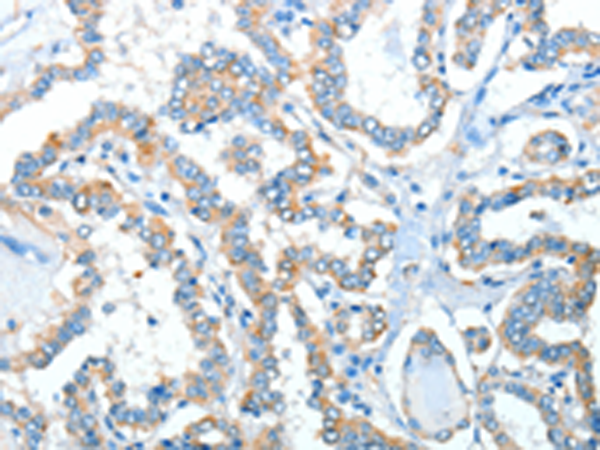

| WB | 咨询技术 | Human,Mouse,Rat |
| IF | 咨询技术 | Human,Mouse,Rat |
| IHC | 1/25-1/100 | Human,Mouse,Rat |
| ICC | 技术咨询 | Human,Mouse,Rat |
| FCM | 咨询技术 | Human,Mouse,Rat |
| Elisa | 1/1000-1/5000 | Human,Mouse,Rat |
| Aliases | ADRA1C; ADRA1L1; ALPHA1AAR |
| WB Predicted band size | 51 kDa |
| Host/Isotype | Rabbit IgG |
| Antibody Type | Primary antibody |
| Storage | Store at 4°C short term. Aliquot and store at -20°C long term. Avoid freeze/thaw cycles. |
| Species Reactivity | Human, Mouse, Rat |
| Immunogen | Synthetic peptide of human ADRA1A |
| Formulation | Purified antibody in PBS with 0.05% sodium azide and 50% glycerol. |
+ +
以下是关于ADRA1A抗体的3篇参考文献摘要示例:
---
1. **文献名称**:*Differential α1-adrenoceptor subtype distribution in human tissues: insights from ADRA1A-specific antibody studies*
**作者**:Michelotti, G.A. 等 (2000)
**摘要**:通过免疫组织化学和Western blot技术,研究团队利用ADRA1A特异性抗体揭示了该受体亚型在人类心血管、前列腺及大脑中的高表达,并验证了抗体在亚型选择性检测中的可靠性。
2. **文献名称**:*ADRA1A upregulation in hypertension: role of autoantibodies and receptor signaling*
**作者**:Garcia-Sainz, J.A. 等 (2005)
**摘要**:研究使用ADRA1A抗体发现高血压动物模型中受体表达显著升高,并证明其与Gq/11蛋白信号通路的异常激活相关,提示其在疾病病理中的潜在作用。
3. **文献名称**:*ADRA1A antibody validation for confocal imaging of neuronal localization*
**作者**:Rokosh, D.G. 等 (2012)
**摘要**:通过共聚焦显微镜和敲除模型验证ADRA1A抗体的特异性,证实其在神经元突触前膜的高密度分布,为研究中枢肾上腺素能调控提供了工具支持。
---
以上文献示例聚焦于ADRA1A抗体的应用场景(如定位、疾病机制、工具验证),摘要涵盖研究目标、方法及关键结论,符合简要概括需求。实际文献需通过PubMed等数据库检索获取。
The ADRA1A antibody targets the alpha-1A adrenergic receptor (ADRA1A), a member of the G protein-coupled receptor (GPCR) family that mediates physiological responses to catecholamines like norepinephrine and epinephrine. ADRA1A is primarily involved in smooth muscle contraction, neurotransmission, and regulation of blood pressure. It is expressed in various tissues, including the heart, blood vessels, prostate, and central nervous system. Research on ADRA1A has been pivotal in understanding cardiovascular diseases, benign prostatic hyperplasia, and neurological disorders, as its activation influences vascular tone, urinary retention, and cognitive functions.
ADRA1A antibodies are essential tools for detecting and quantifying receptor expression in experimental models. They are widely used in techniques such as Western blotting, immunohistochemistry (IHC), and immunofluorescence (IF) to study receptor localization, regulation, and signaling pathways. Specificity and validation of these antibodies are critical, as cross-reactivity with other adrenergic receptor subtypes (e.g., ADRA1B or ADRA1D) can lead to misleading results. Many commercially available ADRA1A antibodies are raised against synthetic peptides corresponding to specific extracellular or intracellular domains, with host species (e.g., rabbit, mouse) and clonal diversity (monoclonal vs. polyclonal) offering flexibility for experimental design. Recent advances in structural biology, including cryo-EM studies of ADRA1A, have further refined antibody development by identifying conformational epitopes, enhancing specificity for functional studies. These antibodies continue to support drug discovery efforts targeting ADRA1A for conditions like hypertension and overactive bladder.
×